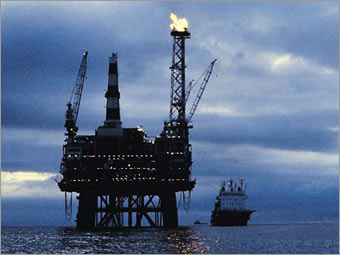
$80 oil lurks
NEW YORK (CNNMoney.com) -- Oil prices are again on a tear.
In the last four weeks, U.S. light crude oil futures have jumped about 12 percent and are now trading some $6 shy of the all-time trading high of $78.40 a barrel for a front-month contract set last July.
So, with both the geopolitical scene and hurricane season heating up, will we see $80 oil in the next few weeks?
"I don't see anything blunting the price rise until it disrupts our way of life," said energy analyst Mike Fitzpatrick, who's firm Man Financial has an $83 target price for crude by the end of September. "With the economy the way it is, that clearly hasn't happened yet."
The recent runup - crude is now above $72 but traded in the low $60s just a month ago - is the result of heightened tensions overseas, expectations of a pickup at refineries (read more demand) and overall a tighter supply and demand picture, said Antoine Halff, head of energy research at Fimat in New York.
On the geopolitical front, a truce between the Nigerian government and rebels who want greater local control over oil revenue is unwinding fast. Oil worker kidnappings have resumed in the African country, which exports over 2 million barrels a day of high quality crude.
In Venezuela, ExxonMobil and ConocoPhillips recently said they were leaving the country after left-leaning president Hugo Chavez tried to renegotiate leases more favorable to the Venezuelan government. The departure of the big oil firms raises question as to whether Venezuela can keep up production, already faltering due to lack of investment in recent years.
And international inspectors are set to release a report any day detailing Iran's nuclear activity, which will almost surely be followed by more tough talk, at least, by both sides in the spat over that country's nuclear program.
Meanwhile, analysts say refiners will start using more crude in coming weeks as they work to churn out gasoline for the summer driving season and begin to make heating oil for winter. Refinery demand for crude typically wanes in the winter and early spring, then picks up in the late spring and summer.
U.S. refiners have been slow to ramp up production this summer due to heavy maintenance and a series of accidents and other problems, but traders expect they eventually will run at greater capacity.
And the supply and demand picture continues to tighten. Earlier this week the International Energy Agency boosted its forecasts for demand for the next few years and cut its supply estimates.
Most analysts say surging demand from developing countries and the United States, combined with a limited amount of new supplies, is the main reason why crude has gone from around $20 a barrel four years ago to over $70 today.
But it's not the only reason. The tight supply-demand picture magnifies the effects of any supply disruption - such as a hurricane in the Gulf of Mexico or even a possible war with Iran - as there is less spare capacity in other parts of the world to pick up the slack.
It has also attracted lots of money from investors betting on crude prices, which one recent study said is adding $10 a barrel to the price.
Nearly everyone agrees that the tight market combined with a big event like a hurricane knocking out Texas refineries or bombs falling over Tehran would push prices soaring above $80.
But barring what industry watches call an "unforeseen event," experts are mixed as to whether crude will hit a record high this summer.
"I see us getting to $75 or $77 without much problem," said Peter Beutel, an oil analyst at Cameron Hanover, a consulting firm. But to go any higher "we would need something to happen."
Fimat's Halff agreed. "I'm not sure we'll see $78, but we'll go back to $75," he said.
But whether crude sets a record this summer or not is beside the point, said Edward Morse, chief energy economist at Lehman Brothers. "It's the macro picture that's important," he said. "It looks like average prices are on track to be higher this year, and higher still the year after."
No comments:
Post a Comment